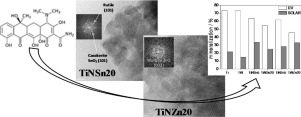Catalysis Today ( IF 5.3 ) Pub Date : 2017-12-18 , DOI: 10.1016/j.cattod.2017.12.017 Luca Rimoldi , Eleonora Pargoletti , Daniela Meroni , Ermelinda Falletta , Giuseppina Cerrato , Francesca Turco , Giuseppe Cappelletti

|
TiO2 modification by both non-metal and metal species is a popular strategy to promote the semiconductor visible light absorption and photocatalytic performance. In this work, tin and zinc are compared as metal promoters to enhance the photocatalytic activity of N-doped TiO2 under solar light. The synthesized samples were tested under both UV and simulated solar irradiation toward the photocatalytic degradation of tetracycline, an emerging water pollutant. All copromoted samples (N + Sn and N + Zn) revealed higher efficiency under solar light in the mineralization of the pollutant with respect to both the pristine and N-doped ones. The enhanced photocatalytic efficiency of these samples was traced back to the modifications introduced by the different guest species to the structural (X-ray Powder Diffraction, XRPD), morphological (High-Resolution Transmission Electron Microscopy, HR-TEM and Brunauer-Emmett-Teller analysis, BET), spectroscopic (X-ray Photoelectron Spectroscopy, XPS, Energy Dispersive X-ray Spectroscopy, EDX and Diffuse Reflectance Spectroscopy, DRS) and surface features (ζ-potential). In this regard, the increased surface area, the modifications of the phase composition and the enhanced visible light harvesting seem to play a pivotal role in affecting the photocatalytic performance. Mass spectrometry analyses allowed us to identify several reaction intermediates and propose different degradation mechanisms depending on the type of metal promoter.
中文翻译:

金属(Sn,Zn)和N物种在太阳光下增强TiO 2的光催化活性的同时作用
非金属和金属物种均对TiO 2进行改性是提高半导体可见光吸收和光催化性能的流行策略。在这项工作中,将锡和锌作为金属促进剂进行比较,以增强N掺杂的TiO 2的光催化活性。在太阳光下。在紫外线和模拟太阳辐射下对合成的样品进行测试,以测定四环素(一种新兴的水污染物)的光催化降解。所有共促进的样品(N + Sn和N + Zn)在原始光和氮掺杂污染物的矿化作用下,在太阳光下均显示出更高的效率。这些样品增强的光催化效率可追溯到不同客体物种对结构(X射线粉末衍射,XRPD),形态(高分辨率透射电子显微镜,HR-TEM和Brunauer-Emmett-Teller)进行的修饰。分析,BET),光谱(X射线光电子能谱,XPS,能量色散X射线能谱,EDX和漫反射光谱,DRS)和表面特征(ζ电位)。在这方面,表面积的增加,相组成的改变和可见光收集的增强似乎在影响光催化性能方面起着举足轻重的作用。质谱分析使我们能够确定几种反应中间体,并根据金属促进剂的类型提出不同的降解机理。


























 京公网安备 11010802027423号
京公网安备 11010802027423号